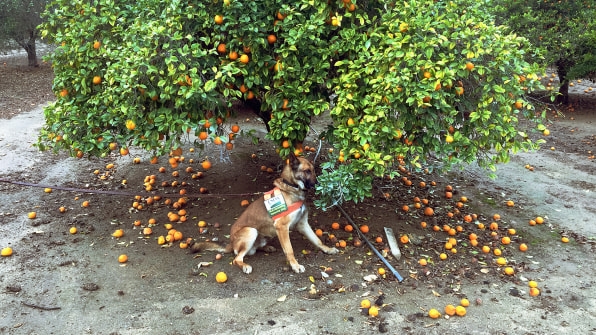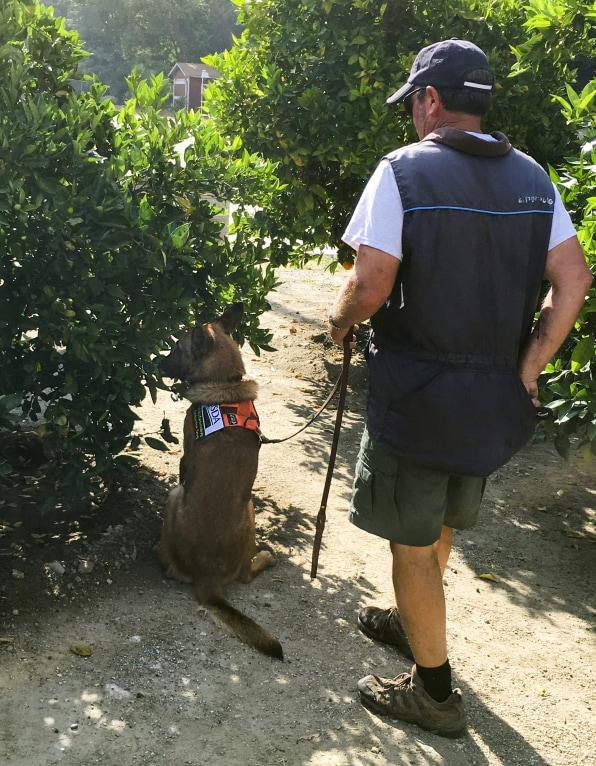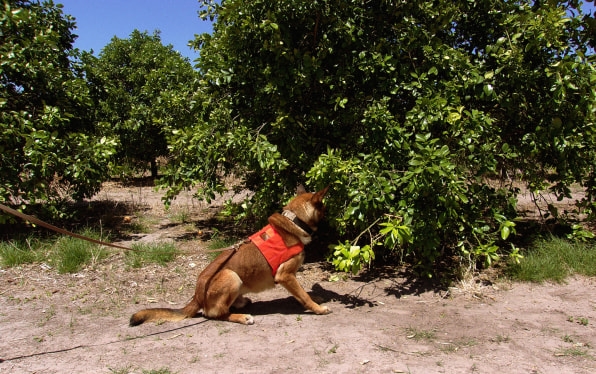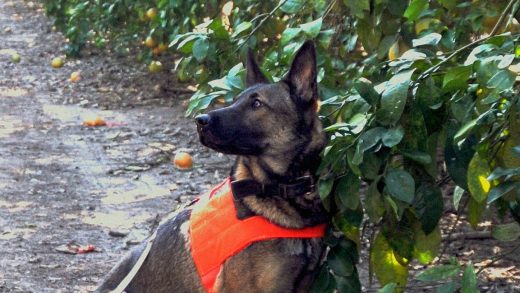These bacteria-sniffing dogs are protecting your orange juice from a global citrus pandemic
The dogs, specially trained by USDA Agricultural Research Service scientists, are able to detect infected trees months or even years before they show symptoms, preventing the spread of citrus greening to more trees in a field. With an accuracy rate between 92% and 99%, these dogs could be the answer to saving the citrus industry.

Citrus greening is a pandemic, now affecting most of the major citrus-producing areas of the world and leading to significant crop loss in the United States. It prevents the tree from taking in as many nutrients as it should, slowly rendering the fruit it produces smaller and curtailing its production. Once one citrus tree is infected, a farm can quickly start losing trees and spending an exorbitant amount of money to detect which ones are contaminated. As part of the 2017-18 state budget, California spent $43 million in its efforts to suppress and eradicate huanglongbing and Asian citrus psyllid, a citrus pest that can spread the bacteria that causes the disease. Between 2005 and 2017, citrus greening was responsible for a 75% decline in Florida’s $9 billion citrus industry.

So far, there have been two main ways to detect citrus greening: visually and molecularly. The former is inefficient, Gottwald says, because infected trees can be asymptomatic for months or years, meanwhile spreading the disease to nearby crops. “The disease is essentially progressing in background all the time, and you can never get ahead of it,” he says. Molecular detection works well, but scientists can run into a sampling problem. “If you have initial detection in a tree with 200,000 leaves, how do you select the right leaf?” says Gottwald. Once scientists have a sample, they still need to bring it back to the lab, extract the DNA, and process that to see if the pathogen is present. “In both cases, you’re spending a considerable amount of time and money to do the scouting, collecting samples, and to process in the laboratory.”
Dogs, on the other hand, are efficient and relatively inexpensive, especially when you factor in the profits saved through early detection. In a paper recently published in Proceedings of the National Academy of Sciences, Gottwald and his team outline how the trained dogs performed when tested. In a few cases where the dogs detected false positives, they were alerting on clean trees that were in the same spot where an infected tree had previously been for an earlier test. The research also found that the dogs are actually detecting the pathogen itself, not the tree’s reaction to the pathogen—meaning it is a direct detection and serves as confirmation that the pathogen is actually there—and they can even distinguish it from other bacteria.

The training process for these citrus-saving canines is similar to that for bomb-detecting dogs, and this work with dogs and citrus trees specifically goes back about 20 years, to when the USDA was working on another crop epidemic, citrus canker. The dogs are so effective, he adds, that it could allow the U.S. citrus industry to remain economically sustainable over a 10-year period, compared to using molecular or visual detection techniques. “[Farmers] end up being able to maintain production and economic viability, even by spending a little more [upfront] using canine detection,” he says. “That’s the only methodology that will maintain a viable and productive agricultural system.”
“This is not a new technology. I like to say it’s 500 to 700 million years old—that’s when the sense of smell actually started to develop in animals,” Gottwald says. “It’s nothing new, it’s just a new application of very old technology that’s had millions of millions of years to optimize. It’s difficult to compete with that.”
(9)



